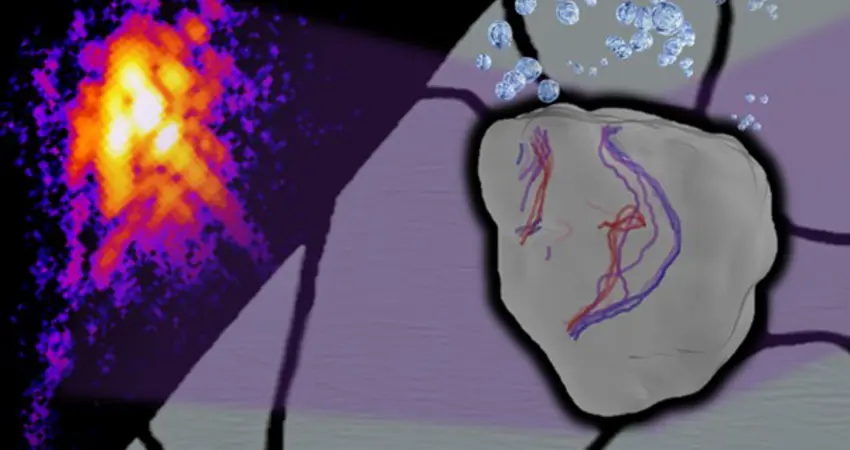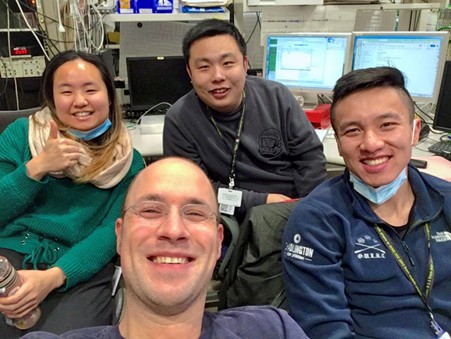11 Sep 2025
First 3D real-time imaging of hydrogen’s effect on stainless steel defects opens the way to a safer hydrogen economy
A study led by University of Oxford and Brookhaven National Laboratory researchers has uncovered how exposure to hydrogen atoms dynamically alters the internal structure of stainless steel

An artistic impression of the experiment showing the evolution of defects with time
In a world-first experiment, the team used an advanced X-ray imaging technique to track how tiny defects inside stainless steel (called dislocations) respond to hydrogen exposure. This is crucial to understand how hydrogen can cause metals to weaken or fail, and could guide the design of next-generation alloys for a growing hydrogen economy. The study ‘Direct Imaging of Hydrogen-Driven Dislocation and Strain Field Evolution in a Stainless Steel Grain’ is published in Advanced Materials.
Lead researcher Dr. David Yang (Brookhaven National Laboratory) says, “Hydrogen has great potential as a clean energy carrier, but it’s notorious for making materials it comes in contact with more brittle. For the first time, we have directly observed how hydrogen changes the way defects in stainless steel behave deep inside the metal, under realistic conditions. This knowledge is essential for designing alloys that are more resilient in extreme environments, including future hydrogen-powered aircraft and nuclear fusion plants.”
"This knowledge is essential for designing alloys that are more resilient in extreme environments, including future hydrogen-powered aircraft and nuclear fusion plants”
As countries aim to transition to fossil-free energy systems, hydrogen has been touted as the ideal fuel for ‘hard to decarbonise’ sectors, such as shipping, aviation, and heavy freight. However, hydrogen can cause unexpected cracking in metals (known as hydrogen embrittlement) which threatens the integrity of high-pressure vessels, pipelines, and critical components in energy systems.
While engineers have long known that hydrogen affects metal performance, the precise mechanisms at the atomic scale have remained elusive, as hydrogen is very difficult to detect.
Study principal investigator Professor Felix Hofmann explains: “Using coherent X-ray diffraction, a non-destructive method, we were able to watch atomic-scale events unfold in real time inside solid metal without cutting open the sample. It has been tremendously exciting analysing this data and piecing together the parts of this scientific puzzle. Some of the results really surprised us by showing up behaviour we weren’t expecting.”
To uncover what hydrogen does inside the material, the researchers used an ultra-bright beamline at the Advanced Photon Source in the US to focus X-rays onto a single stainless-steel grain, roughly 700 nanometres in diameter. They then applied a technique called Bragg Coherent Diffraction Imaging to measure how the internal structure of this grain changed over time. In this method, the X-rays are scattered by the crystal lattice, creating a complex interference pattern. This can be reconstructed to reveal the structure of the grain, the crystal defects within it and how they distort the lattice around them.
"It has been tremendously exciting analysing this data and piecing together the parts of this scientific puzzle. Some of the results really surprised us by showing up behaviour we weren’t expecting.”
By imaging the steel grain over 12 hours, the experiment revealed three key changes once hydrogen was introduced:
- Dislocations became unexpectedly mobile. Internal faults began to move and reshape themselves, even without additional external stress. This suggests that hydrogen acts like a lubricant at the atomic scale, making it possible for defects to move more easily.
- A surprising out-of-plane motion of defects was observed. This upward shift, known as “climb,” is unexpected and signals that hydrogen allows atoms to rearrange in ways that aren’t typically possible at room temperature. This process is thought to play a critical role in reducing the hardness of alloys.
- The dislocation’s surrounding strain field reduced noticeably as hydrogen accumulated. A strain field is the zone around a defect where atoms are pushed or pulled out of place, allowing the material to accommodate the defect. This study provides the first direct, 3D experimental measurement of a long-theorised effect called hydrogen elastic shielding, where hydrogen reduces defect strain fields, effectively shielding the surrounding metal from stress.
These findings help explain why hydrogen can lead to unexpected failure in metals since it allows internal defects to move more easily and in ways that are not normally possible.
According to the researchers, the work directly informs how to model and predict material performance in hydrogen environments, feeding into multi-scale simulation frameworks used by industry. It also points toward potential strategies for engineering novel alloys that offer greater resistance to hydrogen embrittlement.
Professor Hoffman adds, “This research is only possible because of the availability of extremely bright and coherent X-ray beams at international synchrotron sources. The results are highly complementary to information from electron microscopy and simulations. We are now planning even more sophisticated experiments to study how hydrogen changes other types of defects. At the same time, we’re also developing models to help industry design complex hydrogen fuel systems.”

The study also involved researchers from Argonne National Laboratory (United States), and University College London.
Main image: An artistic impression of the experiment: 3D rendering of the micro-scale stainless steel grain investigated in this study showing the evolution of defects inside it with time (early – blue lines, later – red lines). The grain is embedded within a polycrystalline bulk sample, as schematically. By focussing a coherent X-ray beam on this grain, a coherent X-ray diffraction pattern can be measured, from which the shape of the grain and the defects inside it can be reconstructed. By continually monitoring this grain while hydrogen is introduced, researchers studied how hydrogen interacts with defects.




